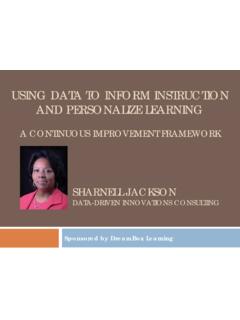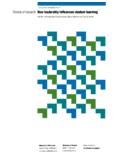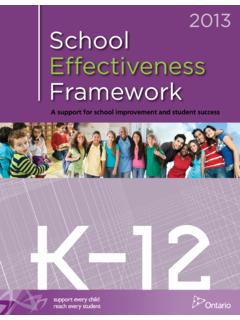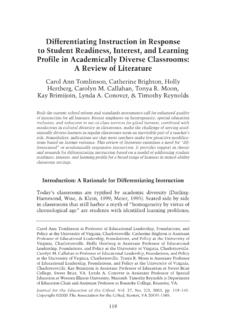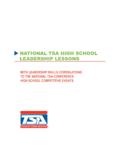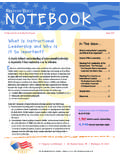Transcription of Improving Student Learning By Supporting Quality Teaching
1 Amy M. Hightower Rachael C. Delgado Sterling C. Lloyd Rebecca Wittenstein Kacy Sellers Christopher B. Swanson December 2011 A Survey of School Finance Policies and Outcomes Improving Student Learning By Supporting Quality Teaching : Key Issues, Effective Strategies Improving Student Learning by Supporting Quality Teaching : Key Issues, Effective Strategies Copyright 2011 by Editorial Projects in Education, Inc. All rights reserved. No part of this publication shall be reproduced, stored in a retrieval system, or transmitted by any means, electronic or otherwise, without the written permission of the copyright holder.
2 Published by: Editorial Projects in Education, Inc. 6935 Arlington Road, Suite 100 Bethesda, MD 20814 Phone: (301) 280-3100 About this Report In this report the Editorial Projects in Education Research Center explored issues related to Teaching Quality and Student Learning , and offers strategies, approaches, and considerations for philanthropic and other organizations. This work should be of particular interest for institutions considering investing in the areas of Teaching and Learning . This document is a slightly revised version of a report prepared for the Toldeo, Ohio-based Stranahan Foundation in April 2010.
3 Editorial Projects in Education is a nonprofit, tax-exempt organization based in Bethesda, Md. Its primary mission is to help raise the level of awareness and understanding among professionals and the public of important issues in American education. EPE covers local, state, national, and international news and issues affecting preschool through 12th grade. Editorial Projects in Education, or EPE, publishes Education Week, America s newspaper of record for precollegiate education; ; and the Top-School-Jobs employment resource. It also produces periodic special reports on issues ranging from technology to textbooks, as well as books of special interest to educators.
4 The EPE Research Center conducts annual policy surveys, collects data, and performs analyses that appear in the Quality Counts and Diplomas Count annual reports. The center also produces independent research reports, contributes data and analysis to special coverage in Education Week and , and maintains the Education Counts and EdWeek Maps online data resources. The study s co-authors are current and former members of the EPE s Research Center and Knowledge Services divisions. We would like to extend our thanks to the Stranahan Foundation and its executive director, Pam Howell-Beach, for Supporting this work.
5 Several individuals also provided helpful guidance for this report, including: Shyrelle Eubanks, senior policy analyst for the National Education Association (NEA); Marci Young, Pre-K Now project director for the Pew Center on the States; Stephen Sawchuk, Assistant Editor, and Debra Viadero, Assistant Managing Editor, for Education Week; Edward Crowe, senior adviser for the Teaching Fellows Program, Woodrow Wilson National Fellowship Foundation; and Segun Eubanks, Teacher Quality Department director for the NEA. Improving Student Learning EPE Research Center | 1 Table of Contents Table of 1 1. Overview .. 2 2.
6 Definitions and Dynamics of Teaching Quality .. 5 Defining Quality Teaching Via Teacher Qualifications .. 6 Influencing the Human Capital Pool .. 10 Contexts that Influence Effective Teaching and Learning .. 16 3. Promising and Emerging Strategies .. 19 Strategies Focusing on Teacher Preparation .. 19 Strategies to Influence the Human Capital 21 Strategies Focusing on School Leadership and Working 25 4. Assessing the Philanthropic Landscape .. 28 Overview of Philanthropic Investments in Teaching Quality .. 28 Major Funders .. 29 5. Conclusion and Recommendations .. 35 What Is Known Research Findings, Strategies, and Grantmaking.
7 35 Future Directions and Recommendations .. 38 References .. 41 Appendix: Profiled Strategies .. 49 Strategies that Focus on Teacher Preparation .. 49 Strategies to Influence the Human Capital Pool .. 50 Strategies that Focus on School Leadership and Working Conditions .. 51 Improving Student Learning EPE Research Center | 2 1. Overview Few topics in education have captured as much attention from policymakers and practitioners as the connection between Teaching Quality and Student achievement. The research has clearly shown that Quality Teaching matters to Student Learning . Teacher Quality has been consistently identified as the most important school-based factor in Student achievement (McCaffrey, Lockwood, Koretz, & Hamilton, 2003; Rivkin, Hanushek, & Kain, 2000; Rowan, Correnti & Miller, 2002; Wright, Horn, & Sanders, 1997), and teacher effects on Student Learning have been found to be cumulative and long-lasting (Kain, 1998; McCaffrey et al.)
8 , 2003; Mendro, Jordan, Gomez, Anderson, & Bembry, 1998; Rivers, 1999; Sanders & Rivers, 1996). However, researchers continue working to untangle important aspects of these relationships, including the specific ways in which Quality Teaching operates, the degree to which it drives Learning , and how effectiveness evolves as teachers progress through their careers. In addition, the field is still seeking clarity about how to develop, measure, and sustain teacher effectiveness. This ongoing research attention is paralleled by momentum at the federal policy level, particularly efforts to strengthen accountability for teacher Quality and, most recently, to define teacher effectiveness (at least in part) based on growth in Student Learning .
9 The No Child Left Behind Act of 2002 (NCLB) defined a highly qualified teacher as one with at least a bachelor s degree, full state teacher certification, and demonstrated knowledge in the subjects taught. States have struggled to implement that definition and track highly qualified teachers within their systems in a meaningful way. As activity heightens around reauthorization of the Elementary and Secondary Education Act, the most recent iteration of which is NCLB, the Obama administration has signaled the importance of coupling federal funding with states abilities to link Student achievement data with the evaluation of teachers and school leaders and their effectiveness.
10 Similar priorities have also been expressed through the federal stimulus, the American Recovery and Reinvestment Act, and especially its education-focused Race to the Top Program. Against this research and political backdrop, this report summarizes the state of research on Teaching Quality , the links to Student Learning , and the contextual factors that play an intermediating role in Teaching and Learning . These findings are complemented by an overview of promising strategies for Improving Teaching Quality . In the interest of providing foundations and other institutions and stakeholders with the most relevant insights for Improving practice and policy, this report intentionally concentrates on the more concrete and actionable aspects of Teaching Quality and instruction rather than relatively subjective and intangible factors like teacher dispositions.

